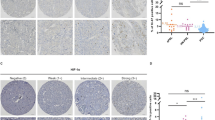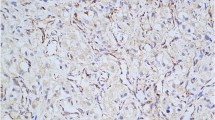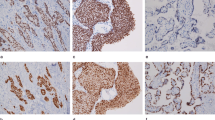Abstract
Pheochromocytomas and paragangliomas arise from the adrenal glands and extraadrenal paraganglia, respectively. Malignant behavior of these tumors is uncommon and is, in part, dependent on their sites of origin, such as extraadrenal location. Morphologic criteria for malignancy of pheochromocytoma and paragangliomas have not been clearly defined. In this study, to clarify the histologic features that distinguish the benign from malignant pheochromocytomas and paragangliomas, we examined metastatic and nonmetastatic tumors using immunohistochemical techniques. A total of eight cases, five pheochromocytomas from the adrenal glands (four benign and one malignant tumor) and three paragangliomas with invasion or metastasis, were studied. The markers used in this study were chromogranin A, synaptophysin, NCAM (CD56), SNAP25, neuron-specific enolase, S-100 protein, and MIB-1. Our results suggest that MIB-1 immunostaining is a useful adjunct marker to predict malignant behavior in these tumors.
Similar content being viewed by others
References
Young JB, Landsberg L. Catecholamines and the adrenal medulla. In: Wilson WB, ed. Williams textbook of endocrinology. 9th ed. Philadelphia: Saunders, 1998; 705–716.
Medeiros LJ, Wolf BC, Balogh K, Federman M. Adrenal pheochromocytoma: a clinicopathologic review of 60 cases. Hum Pathol 16:580–589, 1985.
Van-der-Harst E, Bruining HA, Jaap-Bonjer H, et al. Proliferative index in phaeochromocytomas: does it predict the occurrence of metastases? J Pathol 191:175–180, 2000.
Nagura S, Katoh R, Kawaoi A, Kobayashi M, Obara T, Omata K. Immunohistochemical estimations of growth activity to predict biological behavior of pheochromocytomas. Mod Pathol 12:1107–1111, 1999.
Brown HM, Komorowski RA, Wilson SD, Demeure MJ, Yong-ran Zhu. Predicting metastasis of pheochromocytomas using DNA flow cytometry and immunohistochemical makers of cell proliferation. Cancer 86:1583–1589.
Linnoila RI, Keiser HR, Steinberg SM, Lack EE. Histopathology of benign versus malignant sympatho-adrenal paragangliomas: clinicopathologic studyof 120 cases including unusual histological features. Hum Pathol 21:1168–1180, 1990.
Clarke MR, Wayant RJ, Watson CG, Carty SE. Prognostic makers in pheochromocytoma. Hum Pathol 29:522–526, 1998.
Gupta D, Shidham V, Holden J, Layfield L. Prognostic value of immunohistochemical expression of topoisomerase alpha II, MIB-1, p53, E-cadherin, retinoblastoma gene protein producta, and HER-2/neu in adrenal and extra-adrenal pheochromocytomas. Appl Immunohistochem Molecul Morphol 8:267–274, 2000.
De-Krijger RR, Van-der-Harst E, Van-der-Ham F, Stijnen T, Dinjens WN, Koper JW, Bruining HA, Lamberts SW, Bosman FT. Prognostic value of p53, bcl-2 and c-erbB-2 protein expression in pheochromocytomas. J Pathol 188:51–55, 1999.
Santoro M, Rosati R, Grieco M, Berlingieri MT, D’Amato GLC, Franciscis V, Fusco A. The ret proto-oncogene is consistently expressed in human pheochromocytomas and thyroid medullary carcinomas. Oncogene 5:1595–1598, 1990.
Castilla GL, Moreno AM, Fernandez MMC, Utrilla JC, Fernandez E, Galera-Davison H. Expression and prognosis value of c-erbB-2 oncogene product in human pheochromocytomas. Histopathology 31:144–149, 1997.
Johnson TL, Zarbo RJ, Lloyd RV, Crissman JD. Paragangliomas of the head and neck: immunohistochemical neuroendocrine and intermediate filament typing. Mod Pathol 1:216–223, 1988.
Bhansali SA, Bojrab DI, Zarbo RJ. Malignant paragangliomas of the head and neck: clinical and immunohisto-chemical characterization. Otolaryngol Head Neck Surg 104:132, 1991.
Lloyd RV, Blaivas M, Wilson BS. Distribution of chromogranin and S100 protein in normal and abnormal adrenal medullary tissue. Arch Pathol Lab Med 108:541–544, 1984.
Unger P, Hoffman K, Pertsemlidis D, Thung S, Wolfe D, Kaneko M. S100 protein-positive sustentacular cells in malignant and locally aggressive adrenal pheochromocytomas. Arch Pathol Lab Med 115:484–487, 1991.
John H, Ziegler WH, Hauri D, Jaeger P. Pheochromocytomas: Can malignant potential be predicted? Urology 53:679–683, 1999.
Schlumberger M, Gicquel C, Lumbroso J, Tenenbaum F, Comoy E. Malignant pheochromocytoma: clinical, biological histologic and therapeutic data in a series of 20 patients with distant metastases. J Endocrinol Invest 15:631–642, 1992.
Grouzmann E, Gicquel C, Plouin PF, Schlumberger M, Comoy E. Cancer 66:1833–1835, 1990.
Kimura N, Miura W, Noshiro T, Mizunashi K, Hanew K. Plasma chromogranin A in pheochromocytoma, primary hyperparathyroidism and pituitary adenoma in comparison with catecholamine, parathyroid hormone and pituitary hormones. Endocr J 44:319–327, 1997.
Rao F, Keiser HR, O’Connor DT. Malignant phenochromocytoma: chromaffin granule transmitters and response to treatment. Hypertension 36:1045–1052, 2000.
Portela-Gomes GM, Grimelius L, Johansson H, Wilander E, Stridsberg M. Chromogranin A in human neuroendocrine tumors: an immunohistochemical study with region-specific antibodies. Am J Surg Pathol 25:1261–1267, 2001.
Author information
Authors and Affiliations
Rights and permissions
About this article
Cite this article
Kumaki, N., Kajiwara, H., Kameyama, K. et al. Prediction of malignant behavior of pheochromocytomas and paragangliomas using immunohistochemical techniques. Endocr Pathol 13, 149–156 (2002). https://doi.org/10.1385/EP:13:2:149
Issue Date:
DOI: https://doi.org/10.1385/EP:13:2:149




